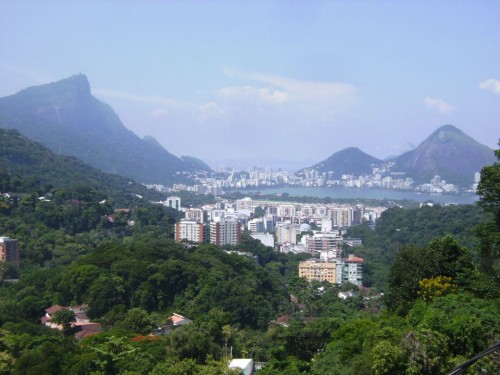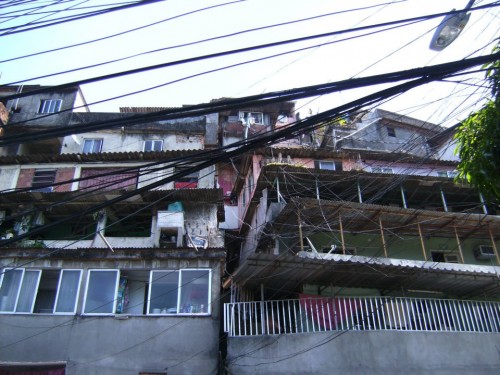My favorite view of Rio de Janeiro wasn’t from Christ’s feet upon Corcovado or even from the top of Sugarloaf Mountain. It was from Rocinha, one of Rio’s largest favelas on a favela tour.
Favelas are illegal settlements primarily built and occupied by lower-class Brazilians. If you’ve seen the movie “City of God” or Snoop Dogg’s music video for “Beautiful” you’ve glimpsed a glammed up version of a favela. Famously located on the hills surrounding Rio, favelas are home to roughly 20% of the city’s metropolitan population. And in an ironic twist, though most lack essential public services such as water, sewage, and garbage removal, they have a million dollar view of Rio’s colorful cityscape, its lush urban forests, and the Atlantic Ocean.

Favela tourism is a touchy topic. Some passionately believe favela tours exploit local communities by turning the impoverished neighborhoods into “human zoos” for rich Westerners to peruse at their leisure. Others think they provide an enlightening experience, exposing well-to-do travelers to the realities of poverty.
I believe both sides are a simplification. I think the experience can be eye-opening but not life changing. I also don’t think a few gringos walking down the street adversely affect any neighborhood—favela or otherwise. In fact, if the guides and drivers are from or connected to the community, and some of the money is used to benefit the residents, I’m hard pressed to find an argument opposed to the practice.
In 2012 I toured Rio’s favelas with a company that donates part of its profits to a local community center that helps children excel in school and move on to higher education. Our driver was a local resident.
What I found most surprising about my visit to these colorful hillside slums was not how dangerous they are (though there are many articles you can read about the drug lords and gun violence), but rather how organized everything was. I’ve lived in several major Latin American cities and capitals, and the slums surrounding them wash away in a downpour or fall down during a minor tremor. In Rio, it is different. The houses are built from concrete and don’t look like they’re going anywhere. And though services can be sketchy and often illegal, tricky wiring allows residents to enjoy electricity, even cable tv.
When I expressed my surprise, our guide informed me that despite their poverty, most favela residents are employed as construction workers, electricians, and plumbers. Basically, favelas are teeming with the types of people that keep the richer neighborhoods down below functioning. So is it any surprise that with a bit of elbow grease and legally-questionable wiring they’ve been able to create a functional community up above?
With hundreds of favelas, some under police control and some not, my observations are vast generalizations. But during my visit to Rocinha and Vila Canoas—a much nicer and smaller favela—I did not feel unsafe or unwelcome. In fact, I felt like I was walking through the outskirts of Mexico City, abet with a much better view.

My reasons for visiting a favela were not altruistic. I visited the favela for myself. I was intrigued, and for me, a vital part of travel is embracing the unknown. I’m not a millionaire and yet I enjoyed strolling the streets of Jardim Botanico (a rich Rio district) for the same reasons I enjoyed my short foray into the favelas: It was new and different and at the end of the day, it helped me understand just a little bit more of this world. Did a 3-hour tour in an air conditioned van teach me what favela life is actually like? Of course not. The tour was a superficial sample. But it was better than no taste at all.
- Get a universal plug adapter
- Get a Car Rental
- Book Your Accommodation HERE
- Get an eSim to be able to use your smartphone abroad.
- Buy Travel Insurance
- Search for Great Tours HERE

2 Responses to “Favela Tours in Rio de Janeiro, Brazil”
Leave a Reply
Tags: article, brazil, rio de janeiro


 Travel to Rio de Janeiro, Brazil – Episode 394
Travel to Rio de Janeiro, Brazil – Episode 394 10 Places of Interest in Rio de Janeiro
10 Places of Interest in Rio de Janeiro Travel to Brazil – Episode 569
Travel to Brazil – Episode 569 Morro de São Paulo, Brazil – The Most Beautiful Island You’ve Never Heard Of
Morro de São Paulo, Brazil – The Most Beautiful Island You’ve Never Heard Of

Zezinho
Says:March 7th, 2015 at 5:39 pm
too bad you didnt go with a local company or didnt get a full walking visit through the neighborhood.
Fabio Mendonça
Says:June 9th, 2019 at 5:44 am
Hello, I am a tour guide of Rio Cultural Secrets (www.rioculturalsecrets.com) and since 2012 and we bring tourist to Favela Santa Marta and Favela do Vidigal. In Favela Santa marta we always use a local guide because are one of the ways to help the local people. As a tour guide in 2013 i was guiding a group of Frenchs and in the end of the tour (they were owners of a French Course) they offered the courses for free to the local guided. This fantastic act helped a lot the locals.